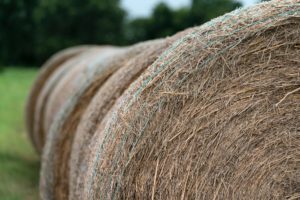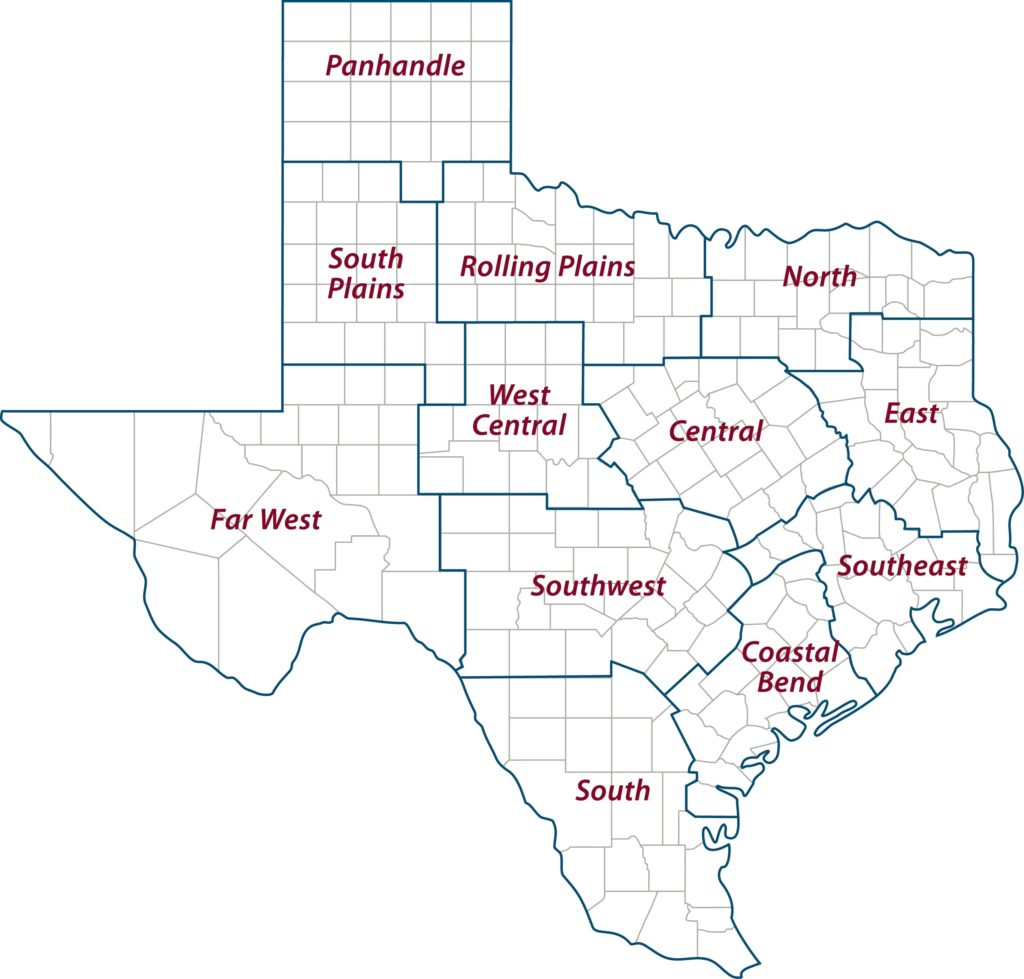Texas hay season looks bleak
Texas Crop and Weather Report – June 22, 2022
The 2022 Texas hay production outlook appears in doubt due to high fertilizer prices and widespread drought, said Texas A&M AgriLife Extension Service experts.

Joe Paschal, Ph.D., AgriLife Extension livestock specialist, Corpus Christi, and Vanessa Corriher-Olson, Ph.D., AgriLife Extension forage specialist, Overton, said dry weather, high temperatures and reduced inputs like fertilizer have inhibited warm-season grass production across much of Texas. Hay quantity and quality are down, while the cost to produce bales is up, and weather forecasts do not look favorable.
Pockets of the state have received decent moisture, they said, but high fertilizer prices have discouraged hay producers from making applications. As a result, hay baled was expected to be of lower quality.
Paschal said prices for supplemental feed like range cubes and hay have continued to increase. Range cubes reached $400 per ton, while round bales were starting to fetch $75-$80. For weeks, AgriLife Extension agents have reported $80-plus bales in extremely dry areas of the state.
Some cattle producers around the state have been culling their herds deeper to reduce stocking rates and “mouths to feed,” Paschal said. But many more face declining grazing, tightening hay supplies and below-average bale production this season.
“People are baling, but it looks like this hay season could be one cutting, maybe two,” he said. “There is hay being fed now, so the hay situation could be tough.”
Avoid overstocking as forage conditions decline
Paschal said hay production and grazing conditions were spotty and mirror scattered rainfall in south Central Texas from Del Rio to Kerrville and east of Corpus Christi back to the Rio Grande River. Some pockets have reported 4-7 inches, but much of that area had not received any rainfall since last fall.
Most of East Texas is experiencing abnormally dry to moderate drought conditions, according to the drought monitor map of Texas produced by the National Drought Mitigation Center at the University of Nebraska. Areas in south Central Texas were showing mostly severe and exceptional drought conditions, which translates into major to exceptional crop and pasture loss and widespread water shortages and restrictions.
Grasses and crop growth are stunted under abnormally dry conditions, and damages begin to show as moderate drought sets in, according to the center. Extremely high temperatures are exacerbating the moisture deficit for plants, including pasture grasses.
Corriher-Olson said weather outlooks suggest Texas will slip further into the drought. Weather systems during hurricane season could change that, but producers with grazing should be implementing contingency plans if they have not already.
“I really don’t have a feel for how many producers are adjusting their grazing management as a result of drought and high fertilizer prices,” she said. “It gets harder to avoid overstocking when forage production is limited. But it puts a lot of producers in a really tight spot when they don’t have the hay or grazing to try and maintain their herd.”
Plan for tight supplies, test hay
Both Corriher-Olson and Paschal expect hay supplies to be tight and low quality going into winter if conditions do not reverse soon.
Drought and fertilization – each of those factors alone can put a dent in hay production, Corriher-Olson said, but both at the same time can be disastrous for both quality and yields. High temperatures also increase Bermuda grass’s fiber content, making it less digestible for cattle.
Fertilizer prices have softened some, Corriher-Olson said, and producers could potentially fertilize ahead of a promising storm system that might provide moisture for a cutting. But cuttings are best at the beginning and end of the season when temperatures begin to decline.
One East Texas producer she talked to is forgoing fertilization this summer to invest input costs into cool-season forage production, she said.
Corriher-Olson said producers should be making decisions regarding stockpiled forages and hay supplies with an expectation of very high bale prices, especially for quality hay, just to cover the cost of fertilizer, pesticide and herbicide applications and diesel.
Paschal said producers should be planning for ways to stretch available nutrition – whether that is finding alternative feed like cotton seed, purchasing failed corn crops or using supplemental feeds with a limiter to reduce the number of trips to feed.
Hay production conditions are better in states east of Texas, he said, and bales are likely to be moved into Texas or cattle are expected to be moved to better pastures. He suggests cattle producers test bales for their nutritional value, whether purchased or produced. Tests can provide information that will better guide cattle supplementation, improving the digestibility and nutritional value of that hay.
Producers can reach out to AgriLife Extension agriculture agents in their county for assistance with hay testing, Paschal said.
“It’s going to be tough,” he said. “There is a lot of hay cows will eat when there is nothing else, but it doesn’t mean it is good. There are ways to stretch a cow’s nutritional needs, but the bottom line is getting the right amount of protein and energy in her.”
AgriLife Extension district reporters compiled the following summaries:
CENTRAL
The district experienced record-high temperatures and no rainfall. Most areas reported short moisture conditions. Dry conditions were dominating the area, and crop conditions were declining. Drought-stressed corn was maturing very rapidly. Expectations for corn were not good due to the 100-degree days and drought at tasseling/silking stages. Farmers finished oat and wheat harvests and were baling hay. Sorghum was coloring, and cotton was flowering. Stock tank levels were quickly declining. Pastures were in poor to very poor condition. Livestock were in fair condition.
ROLLING PLAINS
Days were very hot and windy. Cotton planting was in full swing with very little emerged. Some grasses, hay and Sudan grass were being baled. Corn and sorghum were forming ears and heads, respectively. More Sudan grass was planted and emerged but needed rain. Rangeland conditions and grass production continued to decline, with very poor to fair ratings reported. Some hay cutting occurred, but low yields were reported. Johnson grass meadows made the most hay per acre. Pastures looked good but were starting to burn. Livestock were in decent shape, but heat stress was reported. Stock tanks were dwindling as well.
COASTAL BEND
Drought conditions with wind continued to impact crops. Plants were stressed and stunted. Corn was drying down, and most fields were in poor condition, with a few exceptions in isolated areas. Grain sorghum fields were turning color rapidly, and conditions ranged from very poor to good. There was some concern about sorghum lodging as stalks get drier. Cotton was blooming and setting bolls. Some cotton was zeroed out with some fields already plowed under. Pasture conditions continued to deteriorate, and hay was in short supply. Only pastures that were reserved or were very well managed remain in fair condition. Some hay was made in isolated pockets with better moisture, but most of the reporting area had not produced any bales yet. Hay growers were concerned with prussic acid in Sudan grass and Johnson grass hay. High feed costs were leading to hard livestock management decisions for producers. Many producers were culling their herds deeper and doing some early weaning. Livestock auction prices were still holding steady.
EAST
Abnormally high temperatures and no rain worsened drought conditions. Pasture and rangeland conditions were poor to fair. Subsoil and topsoil conditions were short. Producers finished their first cuttings of hay with yields being far below average. Lack of rain and high fertilizer prices continued to be major concerns. Heavier-weight feeder calf prices were stronger, and slaughter cattle prices were steady. Livestock were in fair to good condition.
SOUTH PLAINS
Subsoil and topsoil moisture levels were adequate in some areas. Producers were working to finish plantings. Cotton was struggling with the heat. Cattle were in good condition.
PANHANDLE
Soil moisture levels were short. Crop conditions were poor to fair. Producers were dusting in grain, hay and silage sorghum. Irrigation pivots were running steady to water corn and sorghum crops. Wheat grain harvest was expected to be very short as many fields were cut for silage and hay or damaged by May hailstorms. Some fieldwork continued. Pasture conditions recovered briefly but with very little vegetative growth due to drought. Overall, rangeland and pasture ratings were poor.
NORTH
Soil moisture levels ranged from short to surplus. High temperatures set in with no rain reported. Producers reported declining pasture conditions. Wheat harvest continued. Grain sorghum, soybeans, sunflowers and cotton were all in good shape and progressing nicely. The hot weather may begin to take a toll on crops if dry conditions persist. Cattle were in good condition. Fly and parasite problems were increasing with the hot weather. Summer pastures were doing well for now.
FAR WEST
Conditions were windy, hot and dry, with a 106-degree high temperature and overnight temperatures in the 70s. Some areas received 1.5 inches of rainfall, while most areas received nothing. Lightning sparked isolated grass fires. Cotton planting was complete. No wheat made it to grain. All hay grazer was planted, and some was irrigated to help it get started. Very few irrigated cotton acres had emerged, and zero dryland cotton had come up. Irrigation water from Elephant Butte Reservoir was being released for cotton fields and pecan orchards around El Paso. Melons and pecans continued to make good progress. Pastures were very barren, and all livestock were being supplemented. Producers were selling off cattle herds due to extreme drought and continued to work late lambs and goats. Shipping of some lambs was underway.
WEST CENTRAL
Hot, dry, windy conditions were prevalent. Temperatures were at or over 100 degrees all week. Row crops were in very poor condition due to heat and lack of moisture. Cotton plantings were winding down, and early planted cotton was emerging. Initial reports on pecan crops were light. Insect pest problems were increasing. Livestock producers were still battling high feed costs and minimal forage in pastures and continued to ship more cattle as conditions worsened. A strong cattle market incentivized producers to cull herds deeper.
SOUTHWEST
Conditions remained dry with no chance of rain in the forecast. Creeks and ponds were drying up, and rivers were running very low. Irrigation capacity was strained, and lack of water was stressing crops. Cotton yield potential could decline without rainfall soon. Corn and grain sorghum yields were negatively impacted due to drought, high temperatures and spider mite infestations. Hay was in short supply. Cattle, sheep and goat prices were holding steady. Rangelands were extremely dry, and producers were supplementing livestock rations. Mesquite bean production was spotty. Bobwhite quail were paring up, and more deer fawns were being seen.
SOUTH
Most areas reported very short moisture levels, while southern areas were reporting short soil moisture levels. Triple-digit temperatures continued with no rainfall. Row crops were progressing well. Cotton was developing quickly in sun and high temperatures. Cotton in Hidalgo County showed excellent boll loads with very little pest pressure, but fields in Willacy County showed drought stress. Some leaf rollers were reported in sesame fields. Peanut plantings continued and should be completed soon. Early planted peanuts were beginning to peg. Corn crops were starting to dent and dry down. Sorghum harvest was underway, and yields looked good. Later-planted sorghum looked better than early planted fields. Hay grazer and Bermuda grass fields should be harvested soon. Crops and grasses in drier areas were browning, and there were concerns about fires. Irrigated pecans, watermelons, cantaloupes and Coastal Bermuda grass were in good condition. Yields in irrigated hay fields were fair. Citrus and sugarcane were being irrigated. Pasture and rangeland conditions were fair to good in some areas, but heat and lack of moisture were starting to take a toll, and many areas had little to no grazing. Livestock producers were having a very challenging time between feeding and watering herds and dealing with respiratory issues. Mesquite trees were putting on beans, which will help wildlife.



